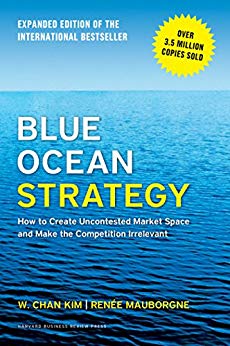

This article is an excerpt from the Shortform summary of "Blue Ocean Strategy" by W. Chan Kim and Renee Mauborgne. Shortform has the world's best summaries of books you should be reading.
Like this article? Sign up for a free trial here .
Blue Ocean Strategy ends with ten Red Ocean Traps that can deter you from creating blue oceans or that jeopardize your execution. These will be phrased as myths that are then debunked:
Red Ocean Trap #1: Blue ocean strategy is a customer-led strategy focusing on existing customers.
- Reality: Blue oceans are about exploring noncustomers and creating new demand. Focusing on how to make your existing customers happier leads to red ocean thinking.
- Still, though, you need to figure out your potential customers’ pain points and why they refuse to participate in an industry.
Red Ocean Trap #2: To create blue oceans, you must leave your core business.
- Reality: It doesn’t have to be this risky or scary. Use your core competencies to discover new blue oceans, where you have a natural advantage. Redefine your industry’s boundaries instead of leaping to a new industry where you have no expertise.
- Casella wines created [yellow tail], Chrysler created the minivan, Apple created the iMac. All leveraged existing capabilities in new product areas.
Red Ocean Trap #3: Blue ocean strategy requires new technologies.
- Reality: Customers don’t care about new technology as much as they do about new value to their lives – in terms of productivity, simplicity, ease of use, convenience, and fun. Don’t obsess over new technology for its own sake, or worry that your strategy can’t survive without brand new tech.
- Starbucks, Comic Relief, and advertising company JCDecaux didn’t use new technology per se – they created a new method of solving a problem.
- And new technologies like the Segway, Philips CD-I, and the Motorola Iridium satellite phone were all technological innovations, but failed to create substantial customer value.
Red Ocean Trap #4: You must be first to market to have a successful blue ocean strategy.
- Reality: It’s more important to be the first company that makes a huge leap in customer value. Speed alone won’t create a blue ocean, and many first-to-market companies have failed.
- Apple’s iMac wasn’t the first PC, and the iPod wasn’t the first MP3 player. Facebook wasn’t the first social network. Instead, they introduced a new value innovation, then continuously leveraged their strengths to grow to immense sizes.
Red Ocean Trap #5: Blue ocean strategy is the same as differentiation strategy. (Traditionally, differentiation is defined as providing premium value at higher cost to the company and higher prices to the customer – think Mercedes-Benz.)
- Reality: Blue ocean strategy is about defining a new value curve that creates more customer value at lower cost. Rather than trying to maximize all factors, blue oceans focus on the critical value factors and eliminates unnecessary factors.
- Don’t just thinking about dialing up factors across the board – consider what you can eliminate as well.
Red Ocean Trap #6: Blue ocean strategy are low-cost strategies that price low.
- Reality: Rather than doing the same thing and pricing lower, blue ocean strategies try to change the basis of competition, with lower cost as a pleasant consequence. Don’t focus purely on offering rock-bottom prices – also raise other competitive factors.
- Also, strategic pricing is set to capture the largest profits, not deliberately set lower than competition. For instance, Apple’s pricing places it far above competitors, but at a level its customers are willing to entertain.
Red Ocean Trap #7: Blue ocean strategy is purely about marketing.
- Reality: A successful strategy requires great propositions of value, cost, and people. Marketing is important, but focusing on this at the expense of other components will cripple the sustainability of the strategy.
- (Shortform example: Recall Segway, which had tremendous marketing but ultimately lacked value and cost propositions.)
Red Ocean Trap #8: Blue ocean strategy is about finding and dominating niches.
- Reality: Blue ocean strategy tries to de-segment buyers by focusing on commonalities across customers and noncustomers, and creating a new value proposition. This creates a larger market than further segmentation.
Red Ocean Trap #9: Blue ocean strategy sees competition as always bad, when it can actually be good.
- Reality: Economically, competition does spur companies to up their game, and this can be good for both the company and society overall. But competition is bad at a certain point: when supply exceeds demand, margins fall, and cutthroat competition begins to seize a share of a declining pie.
- Blue oceans are about creating new pockets of demand that are not currently competitive, to benefit both the firm and the customers.
Red Ocean Trap #10: Blue ocean strategy is synonymous with creative destruction or disruption.
- Creative destruction happens when an innovation displaces an earlier product and captures its users. For instance, digital photography destroyed the market for photographic film.
- Reality: Blue oceans don’t necessitate displacement, because they redefine industry boundaries and reach noncustomers, thus expanding the industry. This is nondestructive creation. Blue oceans don’t focus on finding a better solution to the existing problem.
- (Shortform note: given limited resources of time and money, eventually blue oceans do inevitably displace other industries. Netflix streaming is displacing movie theaters and broadcast TV, for instance.)
———End of Preview———

Like what you just read? Read the rest of the world's best summary of "Blue Ocean Strategy" at Shortform . Learn the book's critical concepts in 20 minutes or less .
Here's what you'll find in our full Blue Ocean Strategy summary :
- What blue oceans are, and how you create one for your business
- Why some businesses succeed in creating blue oceans, and why others fail
- The red ocean traps you have to avoid if you want business growth






